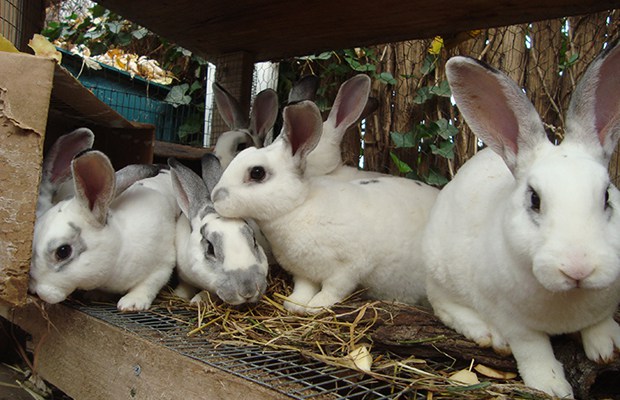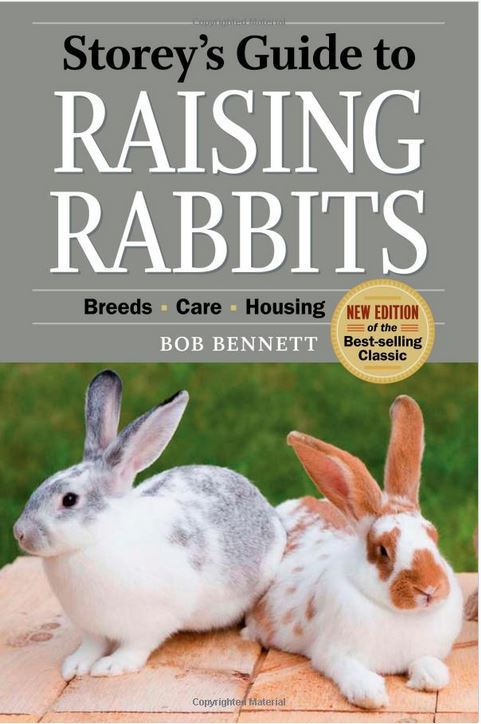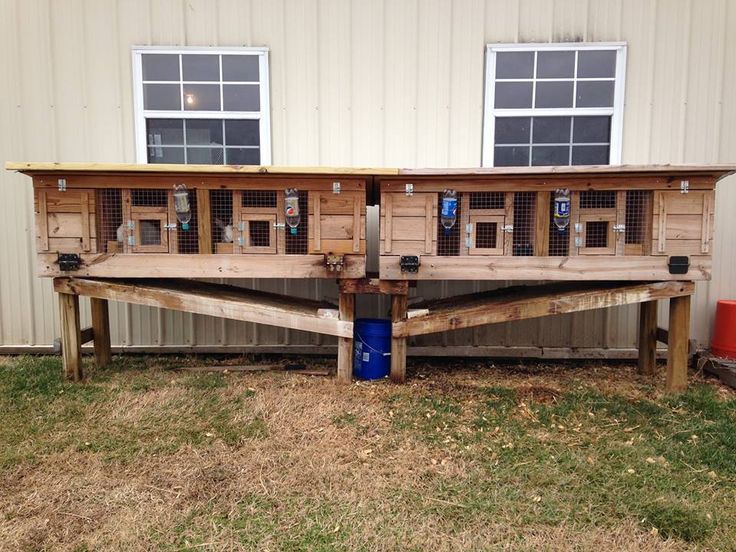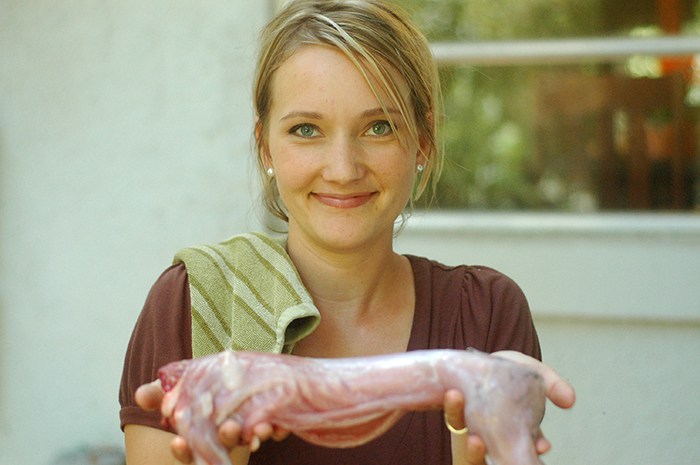
Rabbits truly are the “one-size-fits-all” preppers domestic livestock and after reading the reasons why raising rabbits could be ideal for any prepper, we think you will agree.
Raising Rabbits for the obvious benefit: Meat
Believe it or not, rabbits actually are the most efficient of all livestock in converting feed to muscle mass. That basically means that it is going to take less pellets/grass/weeds per pound of meat to raise a rabbit to butchering size than for any other animal, including chickens. At the same time, rabbits are also faster at reaching butchering size than chickens. For example, if you start incubating eggs the same day that the rabbits are bred, rabbits will be ready to harvest about a month before the chickens are.
Furthermore, rabbits are a little more efficient in terms of man hours and equipment investment required. The female rabbits (known as “does”) do all the work of raising kits. All a person needs to do is supply a nest box. On the other hand, you need an incubator (and electricity) to efficiently raise chickens. (Hens are not the most efficient at raising chicks as this has been bred out of them over time. Actually, even in ancient Egypt there were commercial hatcheries for raising chickens.) Yes, we do keep chickens here, but only for their eggs. Rabbits can easily be kept in cages, even inside the house if need be.
A rabbit will provide enough meat for a family dinner, unlike goats and pigs which will provide a lot more meat, but will also require refrigeration or other means of preserving the excess. Rabbit is an all-white meat that is low in fat and cholesterol while being very high in protein. A common objection to rabbit meat is “rabbit starvation.” This happens when an already truly starving person eats only wild rabbits for a long period. Wild rabbits naturally have far less fat due to the circumstances of their existence.
Domesticated rabbits, on the other hand, are a bit more sedentary and do acquire some fat as a result.
Rabbit meat will also be an important source of food for our dogs. While some cringe at the thought of raising cute bunnies for dog food, our dogs will be critical to our safety and peace of mind in the coming years. Not only will they help protect us and our children during the day, but they will also be on the alert at night, allowing us to get some much-needed sleep. Our dogs will have to be fed. Commercial dog food takes a whole lot of storage space and doesn’t have a long shelf life. And history shows that the woods will be depleted of wild squirrels and rabbits rather quickly.
Bear in mind, however, that not all rabbits are created equal. In fact, many rabbit breeds raised in the US today (and actually, all over the developed world) are merely pets. Commercial meat breeds to consider raising include Californian, New Zealand, Satin, and Flemish giant (for larger families). Rabbit does will need to be bred at least twice per year to maintain higher numbers of kits in the litters. If a doe is bred only once per year, the number of kits in each litter will be lower. Of course, does can be bred much more often.
MANURE
Bunny beans, bunny gold, droppings, doodles—whatever you call it, rabbit manure is by far the most desired of all manures by gardeners. It is higher in nitrogen than any of the other common (chicken, cow, horse, goat, pig, sheep) livestock manures. And nitrogen is what you want for growing lush salad greens and the early phases of corn, tomatoes, and other vegetables. Rabbit manure, like all other livestock manures, is very high in organic matter, which will improve drainage and soil structure.
Rabbit droppings are ideal for boosting decomposition in the compost pile as well
Rabbit manure has all the benefits of steer or chicken manure, but with a substantial advantage. The manures from most other livestock are “hot” and must be composted before adding to the garden. On the other hand, bunny beans are “cold” and can be applied directly into the garden. They are already perfectly pelletized, making controlled application a cinch.
For those gardeners who prefer to compost waste first, rabbit droppings are ideal for boosting decomposition in the compost pile as well. And if you really don’t want to apply the droppings directly to the garden, but don’t wish to wait for them to compost either, you can make a compost tea in just a few days. Simply add a large scoop of manure to a five-gallon bucket, fill with water, and briefly stir it a few times per day for a couple of days. Give your vegetables some of this brew and watch your plants really take off.
And finally, one non-garden use for rabbit pellets (but only the nice dry ones, not the urine-soaked ones): dog treats. Yep, you heard it here first. Most veterinarians will confirm that no self-respecting dog will pass up the opportunity to beg for a few of these gems. They are actually full of vitamins.
In a TEOTWAWKI situation, those people who have decided to raise rabbits for meat and manure will be extremely fortunate. They will be able to instantly kick into meat production for their own families, as well as producing some for barter with others. Let’s face it—very few people will have the desire or the time or resources to raise dozens or hundreds of rabbits. Far better to let the rabbit doe raise her kits to eight weeks of age and then sell breeding pairs to others so that they can supply their own meat and manure needs.
FIBER
And for those who really want to maximize the value of their rabbits, consider the following:
While rabbit pelts have some limited uses in clothing, the fiber from Angora rabbits is far more versatile, and valuable. Angora fiber is seven to eight times warmer than sheep’s wool, while at the same time being much softer, much lighter, and hypoallergenic. It is ideal for baby clothing. While it will take a little practice to learn to spin Angora—like one or two hours—after that it is easy. Spinning wheels are a tad pricey, but Angora can easily be spun on drop spindles. Indeed, there are many spinners who have nice spinning wheels that actually prefer to use a drop spindle for spinning Angora. Drop spindles can run from a few to a hundred dollars; I have one that I purchased for $30 for spinning angora. I actually prefer the ones I’ve made myself from dowels and wooden wheels.
Another advantage of raising Angoras is that some women really benefit from having a creative outlet, and especially so in times of stress. Even a few minutes at the end of the day, before settling down to sleep, can be very calming. In addition, it is also a good activity for younger girls. While one may question the value of time spent spinning and knitting Angora fiber now, once those mittens or socks are on in the dead of winter, all doubts will cease.
French Angora’s – Meat-wise, they weigh in at 7.5 to 10.5 lbs. It’s a good size for the family dinner
Should you decide that Angora rabbits are a good fit for your situation, I’d recommend French Angoras for several reasons, but basically they fit the prepper’s ideal best. Meat-wise, they weigh in at 7.5 to 10.5 lbs. It’s a good size for the family dinner. Giant and German Angoras are larger, but Giants have a reputation for being difficult to breed and produce a litter and also require frequent grooming. Germans may be a good choice, but they are hard to find in North America. English and Satin Angoras are smaller, with Satins having a higher maintenance coat and English having a much, much higher maintenance coat. Avoid crossbreeds—their offspring will be unpredictable with regards to size, coat maintenance requirements, and whether they actually produce good fiber for spinning.
And while on the topic of coat maintenance, you’re probably wondering how much time exactly is required? Really, it’s not much at all—my 11- and 14-year-old daughters spend less than five minutes per week per rabbit on grooming. However, junior rabbits generally require a bit more grooming as it takes a while for the guard hairs that prevent matting to start growing in. Contrast that with the English Angoras which can require up to thirty minutes per day.
MORE
Pets will be a luxury that ultimately few will be able to afford after TEOTWAWKI hits. But an animal can be important therapy for some people. If the pet can also have a productive purpose at the same time, so much the better.
With their relatively small space requirements, rabbits can be kept indoors if necessary, due to being an apartment dweller or to protect them from being stolen. They are much more easily transported and can even ride in a passenger’s lap. Rabbits are perfectly quiet—even a next-door neighbor won’t know you’re raising them. If your rabbits make more manure than what you need for your garden, you can barter the excess to other gardeners in exchange for some produce. With the ability to produce meat faster and more efficiently than any other domestic livestock, and for all the other reasons listed above, rabbits really are one-size-fits-all for preppers.























